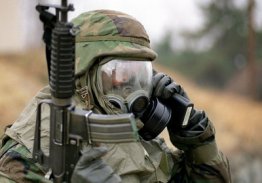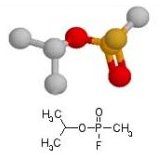Sarin Fact Sheet
|
Sarin is a colorless, odorless, tasteless, human-made chemical warfare agent. It was originally developed in Germany in the 1930's as a pesticide. Sarin is a nerve agent-it disrupts the functioning of the nervous system. Nerve agents are the most toxic and rapidly acting of all known chemical warfare agents. Sarin is highly toxic in both its liquid and vapor states. Delivery: Following the release of sarin into the air, people can be exposed to it through contact with skin or eyes. Sarin can also be inhaled as a gas. Sarin mixes easily with water, and since it is odorless, people would not be aware of sarin in drinking water. Furthermore, sarin in water can be absorbed through the skin. Production: Sarin is made by mixing several commercially available chemicals in the right amounts and in the right sequence. It is debatable how easy it is for the layperson to synthesize sarin. It is somewhat complicated and dangerous to produce. Historic Use: Iraq used sarin in the 1980-1988 war with Iran. The Japanese religious sect, Aum Shinriko, released sarin in Matsumoto in 1994 and the Tokyo subway in 1995. In May 2004, the presence of sarin was detected in the debris of a bomb that exploded in Iraq. |
Treatment: There are antidotes to sarin, but they must be provided very soon after exposure to be effective. Clothing can retain sarin, so it must be removed. The victim should move quickly to fresh air. As quickly as possible after exposure, the victim should wash thoroughly with soap and water. |
|||||
(Sources: CDC, U.S. Army, WHO) |
||||||




